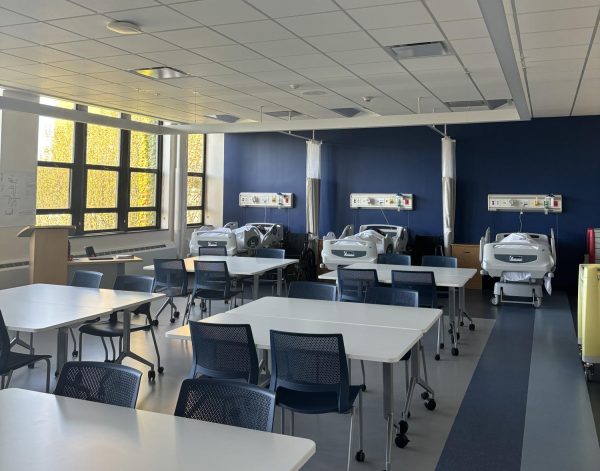COVID-19 cases drop within ETHS and broader Evanston community
As Evanston transitions into spring, one noticeable thing that has been leaving the community, besides the cold weather, is the COVID-19 virus. There has been a significant decrease in the amount of cases in our community since late December and early January, and, as a result, a lot has changed, from the rules surrounding COVID-19 to some people’s outlook on the future of the pandemic.
As the Omicron variant of the virus is infecting fewer people in the Evanston community, it is important to look at where things stood during the first few weeks of winter. As ETHS students transitioned back from winter break during the week of Jan. 14, 128 students tested positive for COVID-19. The week of March 7, only three COVID-19 cases among students were reported. There has been a 96.16 percent decrease in cases among students in the past couple months. Similar trends can be seen in the community of Evanston as a whole. On Jan. 13, amid a large spike in cases like the one seen at ETHS, 221 new positive cases were reported. Compare that to the four new cases reported on March 7, and there has been a 91.16 percent decrease in the number of daily cases.
It is a well known fact that vaccinations and boosters help with controlling the spread of the virus and greatly reduce the chances of hospitalization.
According to Yale Medicine, “In December, a public data analysis from Great Britain found that, in more than 525,000 cases analyzed, the risk of going to the hospital was 65 percent lower for people who had gotten two doses of a vaccine, and 81 percent lower for those who had gotten a booster.”
Using that reference point, it is no surprise that Evanston is doing well with managing the amount of COVID-19 cases in the community. The city has a single-dose vaccination rate of 97.2 percent among residents over 5 years of age. That same trend can be seen at ETHS, with 94 percent of students submitting proof of vaccination, and 95 percent of staff members doing the same. Although there is no available data for the booster rate among Evanston residents or students, the vaccination rate is much higher than that of the U.S. as a whole, which has a rate of 65 percent.
Superintendent Eric Witherspoon attributes the decrease in cases to two main factors.
“I really think that [the reason for the decrease in cases] is probably two things, the mitigations in the state of Illinois, which we adopted locally as others did, combined with the fact that it appears that Omicron has kind of been running its cycle,” Witherspoon said.
One factor that is now a part of determining COVID-19 risk at the high school is the updated CDC COVID-19 research metrics. ETHS is currently projected at a low risk of infection, and Witherspoon is appreciative of the new metric to base decisions on. Before, there was a lot of data out there, but it was unorganized and less helpful than the current CDC data.
“Now, we’ll have a metric on an ongoing basis. Right now, the metric for us is ‘low risk,’ which is the most favorable of them all. But going forward, I’m so glad that we now have that metric, because it was really hard [before],” Witherspoon said.
ETHS has two main methods to track and monitor the number of cases among its staff and student body, and those are SHIELD tests and self-reported cases. SHIELD tests were developed at the University of Illinois Urbana-Champaign and are a form of COVID-19 tests that use a patient’s saliva to determine a positive or negative result. It has an accuracy rate of 99 percent, and results are usually obtained within 24 to 48 hours. Weekly testing during PE/Wellness blocks started after winter break at ETHS, but with the updated COVID policies, testing has been changed to every other week.
During the week of Jan. 14, 122 out of 2569 SHIELD test results were positive among the student body. That is a drastically higher positivity rate than that of the week of March 7, where one out of 1031 tests were positive.
The other method of getting positive results is through the ETHS Covid Notification Form, where students and their families can self-report a positive test result.
Both of these sources are used to update the ETHS COVID-19 Dashboard on a weekly basis.
“Each source provides a ‘snapshot’ of reported positive cases for a given window of time,” Michelle Wheeler, the ETHS Health Center’s lead nurse, explains.
If a student is found to have COVID-19, ETHS continues to follow the same Confirmed COVID Case Procedures as in the past couple of months. That includes contact tracing and quarantining for people who test positive for the virus.
“ETHS will continue to consult with the guidance from the CDC, IDPH, the City of Evanston and the ETHS Medical Advisory Group to determine any changes or adaptations. The district will share updates with all students, staff and families,” Wheeler said.
This decrease in cases is noticeable to the students at ETHS as well.
“In my friend group, there are [fewer] people with COVID. And in my classes as well. Before winter break and a bit afterwards, a lot of kids were absent in my class, and I would get a lot of emails saying that someone in my class got COVID,” said freshman Roee Salant. “But for the past month, pretty much everybody has been in my classes, and I haven’t gotten any positive case emails.”
Salant is happy with the COVID-19 protocols at school and believes that the removal of the mask mandate is a necessary step in getting back to life before COVID.
“I think that removing the mask mandate is a good way of starting to get back to normal,” Salant said. “There might be a small spike in cases at first, but following that, we will hopefully have [fewer] cases. I think we are slowly getting back to normal, and I am pretty excited about that.”
Even though things are looking up, it is important to note that Evanstonians are not likely to live in a world without COVID-19 anytime soon. With spring break comes traveling for many students and their families, and a lot of areas in the country aren’t doing as well with managing COVID-19 as Illinois is.
“We’re a little over a couple of weeks away from spring break, and we know that 70 percent of the country is currently considered at low risk. That means 30 percent of the country isn’t,” Witherspoon pointed out.
ETHS will continue to closely monitor the number of cases at the school and will continue to determine guidelines accordingly. The future is still uncertain, but so far, things seem to be more positive than earlier in the year for the ETHS community.
“We don’t know what a month from now will bring. We don’t know what six months from now will bring,” said Witherspoon. “What we do know is we can be very responsive to whatever the changing situations are.”
Besides that, all members of the community can do is wish for continued improvement.
“I do know that a lot of people are very hopeful that maybe this is a sign that the pandemic could be getting to be endemic and that there may be brighter days in the future when it comes to COVID,” Witherspoon said. “We can certainly hope.”
Your donation will support the student journalists of the Evanstonian. We are planning a big trip to the Journalism Educators Association conference in Philadelphia in November 2023, and any support will go towards making that trip a reality. Contributions will appear as a charge from SNOSite. Donations are NOT tax-deductible.










